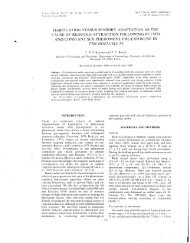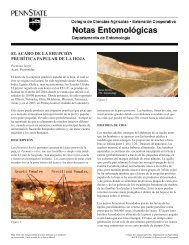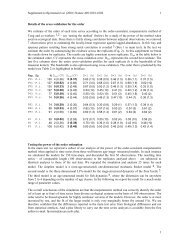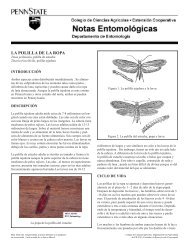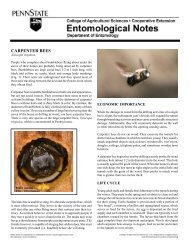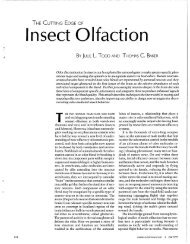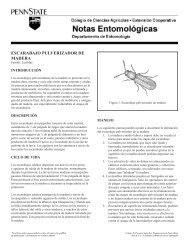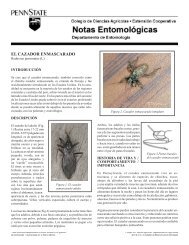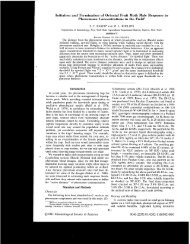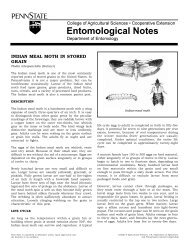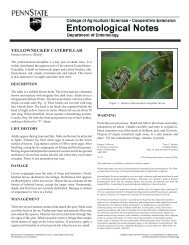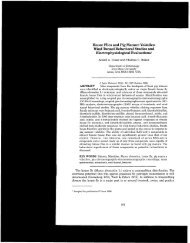odorous papers as effectively as <strong>the</strong>y were<strong>to</strong> <strong>the</strong> natural extract We found that <strong>the</strong>combination <strong>of</strong> two particular fractions,<strong>the</strong> EAG-active one plus ano<strong>the</strong>r one,increased <strong>the</strong> attraction compared <strong>to</strong> <strong>the</strong>one fraction alone. Analysis <strong>of</strong> <strong>the</strong> compoundsin <strong>the</strong>se fractions revealed that <strong>the</strong>EAG-active one contained one compound,(E)-ethyl cinnamate The o<strong>the</strong>r fractioncontained two compounds that wereboth stereoisomers <strong>of</strong> methyl jasmonate' (Nishida et a1 1982)The verification that one <strong>of</strong> <strong>the</strong>se compounds,(2)-methyl epijasmonate, was <strong>the</strong>second pheromone component <strong>and</strong> that@)-ethyl cinnamate was also a pheromonecomponent came from obtaining syn<strong>the</strong>ticsamples <strong>of</strong> <strong>the</strong> compounds <strong>and</strong> presenting<strong>the</strong>m ei<strong>the</strong>r singly or as a blend <strong>to</strong> femaleswho responded by being attracted <strong>to</strong> <strong>the</strong>blend Syn<strong>the</strong>tic samples <strong>of</strong> o<strong>the</strong>r compoundspresent in <strong>the</strong> emission were alsoobtained <strong>and</strong> presented <strong>to</strong> <strong>the</strong> females, yeteven though some were much more abundantthan <strong>the</strong> two pheromone components,<strong>the</strong>y did nothing <strong>to</strong> influence <strong>the</strong>behavior, <strong>and</strong> were judged not <strong>to</strong> be involvedin communication. Therefore, <strong>the</strong>key <strong>to</strong> proving that communication hasoccurred lies in <strong>the</strong> manipulation <strong>of</strong> <strong>the</strong> signalusing syn<strong>the</strong>sized components, alongwith requiring that a significant behavioralresponse be observed in response <strong>to</strong> <strong>the</strong>addition <strong>of</strong> any <strong>of</strong> <strong>the</strong> components Toprove that communication occurs in anymodality, we must prove that we can talkback <strong>to</strong> <strong>the</strong> insectsInterestingly, <strong>the</strong> @)-methyl epijasmonatewas present in such small quantitiesthat we could not get enough for GC-MS analysis <strong>How</strong>ever, for months we feltthat <strong>the</strong> odor from this fraction smelled s<strong>of</strong>amiliar that if we could locate <strong>the</strong> o<strong>the</strong>rsource <strong>of</strong> it we might get enough <strong>to</strong> be able<strong>to</strong> identify it This component had a slightlyherbal, slightly floral, slightly fruity odor,yet we could not remember exactly wherewe had smelled it before! Then one day one<strong>of</strong> us, Ritsuo Nishida, sniffed a whole uncutlemon before he prepared it <strong>to</strong> squeeze itin<strong>to</strong> his tea, <strong>and</strong> immediately realized that<strong>the</strong> oriental fruit moth hair-pencil coponentwas in <strong>the</strong>re Eventually, after analysis <strong>of</strong><strong>the</strong> air borne volatiles from lemons, <strong>the</strong> (Z)-methyl epijasmonate proved <strong>to</strong> be a heret<strong>of</strong>oreunidentified odorant from lemon<strong>and</strong>, nanogram-for-nanogram, was <strong>the</strong>most powerful odorant yet identified fromthis fruit. The odor is familiar <strong>to</strong> us as <strong>the</strong>nondescript "fruit-bin'' odor that we arehardly conscious <strong>of</strong> as we walk past piles <strong>of</strong>lemons, limes, <strong>and</strong> o<strong>the</strong>r citrus fruits in <strong>the</strong>grocery s<strong>to</strong>re The fragrance industry that isinvolved with lemon-scented cleaning <strong>and</strong>1 1 1 2 1 3 1 4 1 5 1 6 1 71 8 1 9 10 11 1Fraction numberl2 ,HFig 3. Gas chroma<strong>to</strong>graphzc ~ecordzng (packed column) <strong>of</strong> male G molesta hazrpenctl extract,showing <strong>the</strong> relatzue abundance <strong>of</strong> unknown components <strong>and</strong> <strong>the</strong> fractzons taken by researchers fortestzng zn electroantennographzc <strong>and</strong> behauzoral bzoassays Four compounds that were zdentzfzedfrom <strong>the</strong> extract zncluded two (compounds 1 <strong>and</strong> 4 (E)-ethyl cznnamate <strong>and</strong> (1 R,2S)-(+)-(Z)-methylepzlasmonate, respectzuely), that when added <strong>to</strong>ge<strong>the</strong>r evoked szgnzficant levels <strong>of</strong> attractzon <strong>of</strong>female G molesta females zn behauzoral assays Compounds 2 <strong>and</strong> 3 were behauzorally znactzue, eventhough 2 was over 10 tzmes as abundant as <strong>the</strong> o<strong>the</strong>r compounds, <strong>and</strong> even though 3 dzffers from 4only by uzytue <strong>of</strong> being a steyeozsome~ To <strong>the</strong> human nose, 3 zs uzrtually odorless, whereas 4 has apleasant, herbally fruzty aroma lzke that <strong>of</strong> an uncut lemonpolishing agents became interested in manufacturingthis epime~ <strong>to</strong> add <strong>to</strong> <strong>the</strong>irproducts for communicating <strong>to</strong> humans <strong>the</strong>sensation <strong>of</strong> "lemon-freshness."Ano<strong>the</strong>r interesting sidelight camewhen Ritsuo Nishida read that methyl jasmonatewas known in <strong>the</strong> perfume industryas <strong>the</strong> "queen <strong>of</strong> aroma" <strong>and</strong> was one <strong>of</strong> <strong>the</strong>oldest <strong>and</strong> most widely used compounds byperfumers, extracted initially from jasmineplants Fur<strong>the</strong>r ~esearch by Terry Acree <strong>and</strong>Ritsuo Nishida revealed, however, that <strong>of</strong><strong>the</strong> four possible epimers, only lR, 2s-(+)-(Z)-methyl epijasmonate, <strong>the</strong> compoundinvolved in <strong>the</strong> courtship pheromone blend<strong>and</strong> contributing <strong>to</strong> attraction, was stronglyfragrant <strong>to</strong> <strong>the</strong> human nose (Acree et a11985) The o<strong>the</strong>r three stereoisomers comprising97% <strong>of</strong> <strong>the</strong> "queen <strong>of</strong> aroma,"proved <strong>to</strong> be virtually odorless! The beautifulfragrance attributed for years <strong>to</strong> <strong>the</strong>methyl jasmonate actually came from animpurity present at about 3% in <strong>the</strong> methyljasmonate, <strong>and</strong> this impurity is <strong>the</strong> orientalfruit moth courtship phe~omone component!Who would have thought that moth<strong>and</strong> human courtship fragrances would beso closely intertwined, <strong>and</strong> both could involvea signal ga<strong>the</strong>red initially from plantchemicals? We found subsequently thatmales lacking <strong>the</strong> hairpencil compound@)-ethyl cinnamate can imbibe it fromsugar water <strong>and</strong> incorporate it in<strong>to</strong> <strong>the</strong>irhairpencils for use as a pheromone, anexample <strong>of</strong> a reflected chemical signal(Nishidaet a1 198 5,L<strong>of</strong>stedtet a1 1989).The responses <strong>of</strong> insects receiving soundemissions must be assessed in <strong>the</strong> samefashion <strong>to</strong> underst<strong>and</strong> which elements aremost critical <strong>to</strong> successful communicationFirst, a discriminating way <strong>to</strong> measure <strong>the</strong>response must be developed, <strong>and</strong> an example<strong>of</strong> this is with Teleogryllus oceanicusfemales made <strong>to</strong> walk on a styr<strong>of</strong>oampretzel <strong>and</strong> choose whe<strong>the</strong>r <strong>to</strong> go right orleft at choice-points during <strong>the</strong>ir walk. Responses<strong>to</strong> natural emissions replayed fromaudio tape were compared in this way <strong>and</strong>showed that <strong>the</strong> females could discriminatefrom among hybrid <strong>and</strong> even hybrid siblingmale songs, based on slight differences in<strong>the</strong> patterns <strong>of</strong> amplitude modulation(Bentley & Hoy 1974) One useful feature<strong>of</strong> this assay is that <strong>the</strong> responder is notallowed <strong>to</strong> take itself in<strong>to</strong> an area where <strong>the</strong>sound pressure level from one <strong>of</strong> <strong>the</strong> twoloudspeakers becomes greater than <strong>the</strong>o<strong>the</strong>r, <strong>the</strong>reby biasing <strong>the</strong> choice withoverall amplitudeThe rule in acoustic communicationthus far, whe<strong>the</strong>r it be for crickets, grasshoppers,drosophilid fruit flies, <strong>and</strong> eveninsects such as leafhoppers <strong>and</strong> lacewingsthat transmit <strong>the</strong>ir pressure disturbancesthrough a substrate such as a plant, has beenthat signals among species differ in patternsWinter 1993215
<strong>of</strong> amplitude modulation. For example?leafhoppers, Graminella nigrifrons sendvibrations through plants <strong>and</strong> <strong>the</strong>n wait <strong>to</strong>hear an answer. Males <strong>the</strong>n begin movingup <strong>the</strong> plant, <strong>and</strong> by a type <strong>of</strong> trial <strong>and</strong> errorwith regard <strong>to</strong> walking up one branch orano<strong>the</strong>r, <strong>the</strong>y arrive at <strong>the</strong> answering femalewho is stationed near <strong>the</strong> <strong>to</strong>p (Hunt et al.1992). In <strong>the</strong>ir work. Hunt et a1 used a Kaysonoiraph from <strong>the</strong>'audiology <strong>and</strong> speech<strong>the</strong>rapy department at University <strong>of</strong> Kentucky.To learn <strong>the</strong> language <strong>of</strong> an insect,en<strong>to</strong>mologists used an instrument affectingour own ability <strong>to</strong> communicate. Theydetermined that only a small fraction <strong>of</strong>amplitude-modulated vibrational pressuredisturbances is actually important in attractingmatesaIn a similar way, <strong>the</strong> parts <strong>of</strong> fireflyemissions that are important <strong>to</strong> communi,-cation were discerned by using syn<strong>the</strong>sizedsignals, in this case generated from flashlights.In <strong>the</strong> classic work <strong>of</strong> James Lloyd(19661, he determined that <strong>the</strong> carrier frequency,or color? <strong>of</strong> <strong>the</strong> light emitted byflying males was not that critical for evokinga response from females resting in <strong>the</strong>foliage <strong>and</strong> vice versa (Fig,, 2B), <strong>How</strong>ever,<strong>the</strong> way in which males flashed <strong>the</strong>ir lightthatis, modulated its amplitude-including<strong>the</strong> pulse duration <strong>and</strong> <strong>the</strong> interpulseinterval? was in fact critical" The intervalbetween <strong>the</strong> flash <strong>of</strong> <strong>the</strong> male <strong>and</strong> <strong>the</strong> (usually)single response pulse from <strong>the</strong> femalewas also crucial <strong>to</strong> evoking - an orientationresponse from males, who continued <strong>to</strong>approach females that responded by flashingat <strong>the</strong> appropriate interval (Fig. 2E)Although chemical signals are rarely inany obvious way amplitude modulated by<strong>the</strong> actions <strong>of</strong> <strong>the</strong> emitter, fluctuations in <strong>the</strong>intensity <strong>of</strong> pheromone concentration, infact, do occur <strong>and</strong> have been shown <strong>to</strong> becrucial for sustained communication. Theimportant fluctuations in amplitude forchemical signals come from <strong>the</strong> mechanicalshearing <strong>of</strong> odor as it is released from asource such as a female gl<strong>and</strong>? creatingsmall-scale turbulence. little eddies, thatdownwind result in pockets <strong>of</strong> clean airinterspersed with dense str<strong>and</strong>s, or filaments,<strong>of</strong> pheromone. We have found with<strong>the</strong> oriental fruit moth that <strong>the</strong> intermittentcontact with <strong>the</strong>se filaments is essential <strong>to</strong>sustaining upwind flight <strong>of</strong> males.<strong>How</strong> do we know this? The sex heromone<strong>of</strong> <strong>the</strong> oriental fruit moth consists <strong>of</strong>three com-ponents 6% E8-12:Ac + 3% Z8-12:OH in Z8-12:Ac, as discovered byanalyzing <strong>the</strong> emissions <strong>and</strong> responses asdescribed earlier for this species' courtshippheromone (Fig 2C) (Roel<strong>of</strong>s et a[. 1969,Card6 et al. 1979). The carrier frequencyi,,e,,<strong>the</strong> blend-was <strong>the</strong>n varied syn<strong>the</strong>ti-cally, along with <strong>the</strong> overall emission amplitude-ie", <strong>the</strong> concentration-<strong>and</strong> a responsepr<strong>of</strong>ile was formed from both fieldtrapping tests <strong>and</strong> wind tunnel studies As in<strong>the</strong> case <strong>of</strong> sound <strong>and</strong> light communicationsystems? <strong>the</strong> carrier frequency that turnsout <strong>to</strong> be optimal for moths is centeredaround <strong>the</strong> naturally emitted female blend.Also, as is typical for sex pheromones, <strong>the</strong>discrimination for carrier frequency is exquisitely<strong>and</strong> narrowly tuned in males?which differs markedly from sound systemsin which <strong>the</strong>re is ver y broad tuning <strong>and</strong> littlediscrimination simultaneously for both <strong>the</strong>emission quality (carrier frequency) <strong>and</strong>amplitudeIn <strong>the</strong> wind tunnel, EAG results showedthat a male oriental fruit moth antenna doesreceive intermittent stimulation from <strong>the</strong>filaments <strong>of</strong> pheromone downwind Evenin <strong>the</strong> field? we showed that 3, lo? or even 30meters downwind <strong>the</strong> antenna receives significantfluctuations <strong>of</strong> pheromone concentration<strong>and</strong> successfully registers <strong>the</strong>m? asin <strong>the</strong> wind tunnel (Fig" 2F) (Baker &Haynes 1989) Then we showed that malesdo need fluctuating stimulation <strong>to</strong> sustain<strong>the</strong>ir upwind flight? by using a wind tunnelin which we could create a uniform cloud orfog <strong>of</strong> pheromone We also pulsed <strong>the</strong> cloudat ei<strong>the</strong>r one per second or one per twoseconds, with a similar period <strong>of</strong> clean airbetween <strong>the</strong> pulses. The males flew upwindonly when <strong>the</strong> cloud was pulsed When presentedwith <strong>the</strong> uniform, constant fog <strong>of</strong>pheromone, however, males exhibitedwide crosswind "casting" flight whilekeeping station momentarily after taking<strong>of</strong>f It appeared as if <strong>the</strong>y adapted quickly <strong>to</strong><strong>the</strong> uniform cloud <strong>and</strong> behaved as <strong>the</strong>ywould had <strong>the</strong>y just lost pheromone <strong>and</strong>flown in<strong>to</strong> clean air (Baker et a1 1985).Fur<strong>the</strong>r analysis <strong>of</strong> <strong>the</strong> behavior <strong>of</strong> orientalfruit moth males in response <strong>to</strong> quickexposures <strong>to</strong> <strong>and</strong> loss <strong>of</strong> pheromoneshowed that <strong>the</strong>y respond within 117 s <strong>to</strong>ei<strong>the</strong>r odor-on or odor-<strong>of</strong>f They reversed<strong>the</strong>ir course across <strong>the</strong> wind-line-i e.? zigzagged-anaverage <strong>of</strong> seven times per second,<strong>and</strong> with a single exposure <strong>to</strong> clean airfollowing loss <strong>of</strong> pheromone <strong>the</strong>y flewmore across <strong>the</strong> wind on <strong>the</strong> very next reversal<strong>to</strong> begin casting flight. Their response<strong>to</strong> contact with pheromone on <strong>the</strong>o<strong>the</strong>r h<strong>and</strong>, was <strong>to</strong> fly more directly upwindon <strong>the</strong> very next reversal after contactingpheromone <strong>and</strong> reverse more frequently, <strong>to</strong>create an upwind surge Considering that<strong>the</strong> EAG results showed that males willencounter only about two or three filamentsper second if <strong>the</strong>y fly straight upwindin <strong>the</strong> plume, <strong>the</strong> 117s reaction time <strong>of</strong> males<strong>to</strong> ei<strong>the</strong>r pheromone on or <strong>of</strong>f meant that<strong>the</strong>re is <strong>the</strong>refore time between filamentsfor <strong>the</strong> males' behavior <strong>to</strong> change <strong>to</strong> crosswindcasting flight? even while "in" <strong>the</strong>time-averaged plume. There is also time for<strong>the</strong> male <strong>to</strong> react by surging upwind <strong>to</strong> eachfilament. We believe that what we see in azigzagging flight track <strong>the</strong>refore is a kind <strong>of</strong>hybrid response that averages out <strong>to</strong> bezigzagging-i.e., tracks that are not fullycrosswind casting or fully upwind surg-ing-because <strong>the</strong> moth is usually in transitionfrom one <strong>to</strong> <strong>the</strong> o<strong>the</strong>r due <strong>to</strong> <strong>the</strong>timing <strong>of</strong> <strong>the</strong> intermittency <strong>of</strong> <strong>the</strong> simulation(Baker 1990),Why should such a quick <strong>and</strong> highlyphasic response evolve? We think it mayhave <strong>to</strong> do with <strong>the</strong> challenge faced by maleoriental fruit moths, as well as by males <strong>of</strong>some o<strong>the</strong>r insect species that must flyupwind <strong>to</strong> odor sources in quickly shiftingwind fields (Baker 1990). They mustrespond <strong>to</strong> every filament caused by smallscaleturbulence by surging upwind, because<strong>the</strong> combination <strong>of</strong> odor plus winddirection points, in many environmentalsituations? directly <strong>to</strong>ward <strong>the</strong> source. Conversely,males must begin <strong>to</strong> s<strong>to</strong>p <strong>the</strong>ir upwindsurge <strong>and</strong> begin casting quickly <strong>to</strong>keep <strong>the</strong>ir station in clean air in order <strong>to</strong>avoid plunging very deeply in<strong>to</strong> a largepocket <strong>of</strong> clean air caused by a large-scalewind shift; <strong>the</strong>y quickly become far<strong>the</strong>r <strong>and</strong>far<strong>the</strong>r displaced from <strong>the</strong> new position <strong>of</strong><strong>the</strong> odor if <strong>the</strong>y proceed upwind withoutpheromone, Casting will also increase <strong>the</strong>irchances <strong>of</strong> recontacting odor that hasmoved <strong>of</strong>f <strong>to</strong> one side or <strong>the</strong> o<strong>the</strong>r due <strong>to</strong>such a shift in wind direction caused bylarge-scale turbulence. Thus, it behoovesmales <strong>to</strong> respond quickly <strong>to</strong> every pocket <strong>of</strong>clean air? even small-scale ones? by castingas soon as it is detected, because it may turnout <strong>to</strong> be one <strong>of</strong> <strong>the</strong> large pockets inevitablylooming ahead (Baker 1990). If, on <strong>the</strong>o<strong>the</strong>r h<strong>and</strong>? <strong>the</strong> pocket is only one <strong>of</strong> <strong>the</strong>many little ones, <strong>the</strong> male is still in position<strong>to</strong> hit <strong>the</strong> next filament. Thus, although amale moth flying upwind in response <strong>to</strong>pheromone may appear <strong>to</strong> be in contactwith <strong>the</strong> plume, it really is never in contactwith pheromone for any period <strong>of</strong> time atall. he male is ei<strong>the</strong>r encountering filamentsfrequently due <strong>to</strong> small-scale turbulence?in which case <strong>the</strong> upwind surges arerapidly, reiteratively elicited, or else infrequently?in which wide, infrequent reversalsare made crosswind, which allow it <strong>to</strong>recontact <strong>the</strong> odorWith regard <strong>to</strong> pheromone recep<strong>to</strong>rsystems, <strong>the</strong> consequence <strong>of</strong> not meeting<strong>the</strong> challenge <strong>of</strong> recovering quicklyenough after exposure <strong>to</strong> intermittent pheromonestimulation is recep<strong>to</strong>r adaptation.Adaptation is <strong>the</strong> reduction in a recep<strong>to</strong>rcell's firing response <strong>to</strong> a stimulus with



